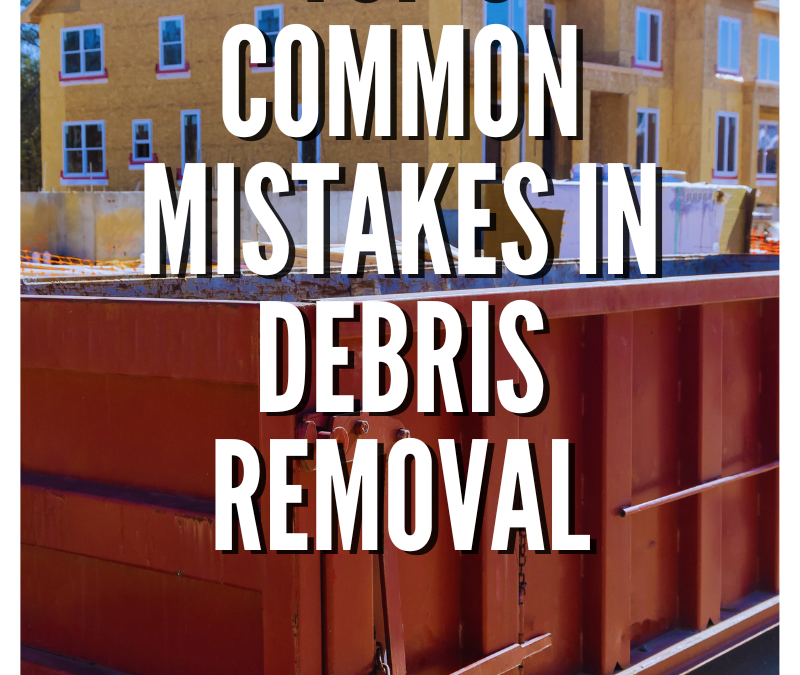Top 5 Common Mistakes in Debris Removal and How to Avoid Them
Debris removal is a crucial step in many construction, landscaping, and renovation projects. It’s essential for clearing the way for new work, maintaining safety, and ensuring that the job site remains productive. However, it’s easy to make mistakes that can lead to inefficiencies, added costs, or even safety hazards. Here are the top five common mistakes in debris removal and tips on how to avoid them.
1. Underestimating the Amount of Debris
One of the most common mistakes is underestimating how much debris will need to be removed. This can lead to delays, increased costs, and potential safety issues.
How to Avoid It:
- Conduct a Thorough Site Inspection: Before starting the removal process, take a detailed look at the site. Consider the type of debris and its volume.
- Use Accurate Measurements: Measure the debris pile or area to estimate the amount more accurately. Tools like laser distance meters can help with precision.
- Plan for Extra Capacity: Always plan for more than you think you’ll need. It’s better to have a bit of extra capacity than to run out of space or resources.
2. Neglecting Proper Safety Protocols
Safety should be a top priority during debris removal. Neglecting safety protocols can lead to accidents, injuries, or damage to property.
How to Avoid It:
- Wear Appropriate Personal Protective Equipment (PPE): Ensure all workers are equipped with helmets, gloves, goggles, and other necessary PPE.
- Use Proper Equipment: Employ the right machinery and tools for the job. Skid steers, for example, are effective for large-scale debris removal.
- Keep the Area Clear: Maintain a clean and organized work area to prevent trips, falls, and other accidents.
3. Failing to Sort Debris Correctly
Mixing different types of debris can complicate disposal and recycling processes, leading to inefficiencies and higher costs.
How to Avoid It:
- Sort Debris on Site: Separate debris into categories like wood, metal, concrete, and general waste. This helps in recycling and disposal.
- Use Designated Containers: Utilize containers or bins labeled for specific types of debris to streamline sorting and removal.
- Follow Local Regulations: Adhere to local waste management regulations for sorting and disposing of different types of debris.
4. Ignoring Environmental Considerations
Improper debris removal can negatively impact the environment. This includes pollution from improper disposal or harm to local wildlife.
How to Avoid It:
- Follow Eco-Friendly Practices: Opt for recycling and proper disposal methods to minimize environmental impact.
- Dispose of Hazardous Materials Properly: Be aware of and follow regulations for handling and disposing of hazardous materials like asbestos or chemicals.
- Minimize Dust and Pollution: Use dust suppression techniques and ensure machinery is well-maintained to reduce emissions and pollution.
5. Inadequate Planning and Scheduling
Without proper planning and scheduling, debris removal can lead to project delays and increased costs.
How to Avoid It:
- Create a Detailed Plan: Develop a comprehensive debris removal plan that includes timelines, equipment needs, and manpower requirements.
- Coordinate with Other Contractors: If other work is ongoing, coordinate debris removal efforts to avoid conflicts and ensure a smooth workflow.
- Monitor Progress: Regularly review progress against the plan and adjust as necessary to stay on track.
How Laborde Land Management Can Help
If you’re facing a debris removal challenge, Laborde Land Management is here to assist. Our team is equipped with the expertise and tools necessary to handle debris removal efficiently and effectively. We ensure that all safety protocols are followed, debris is sorted and disposed of properly, and environmental considerations are prioritized. With our skilled professionals and advanced equipment, including skid steers and specialized machinery, we can help streamline the debris removal process, keeping your project on track and within budget.
For reliable, professional debris removal services, contact Laborde Land Management today and let us take care of the heavy lifting!
Conclusion
Effective debris removal requires careful planning, adherence to safety protocols, and consideration of environmental impact. By avoiding these common mistakes and partnering with experts like Laborde Land Management, you can ensure a smoother, more efficient debris removal process that contributes to the overall success of your project. Whether you’re tackling a small renovation or a large construction job, attention to detail and professional assistance will help you achieve the best results.

